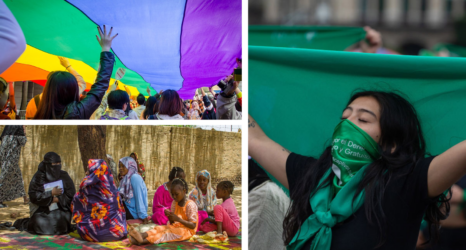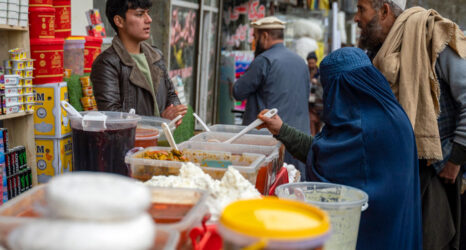Last week, Saudis braced the rainy Manhattan skies and took to the United Nations headquarters to discuss their country’s capital. The four-day interactive pop-up event, “A Day in Riyadh,” showcased the Saudi capital as a cosmopolitan business hub—with women often at the center.
Arabic coffee flowed into delicate cups and decorative books on the history of Riyadh were distributed. The space was transformed into an interactive area, with images of all sizes engulfing the space. Photographs depicting the old and modern Riyadh were juxtaposed near the visible windows overlooking Turtle Bay and the East River as English and Arabic speakers filled the room.
The event made sure women—with their faces uncovered—were included in all of their videos depicting Saudi families. They brought in dynamic female members of the Shura Council, the advisory board to the king, who candidly spoke about how Riyadh is becoming a more feminist city. The UN events discussed transportation, education and architecture, but the most empowering session—and the crowd favorite—was the one related to women. Each session ended with a lively and unfiltered Q&A session, in which questions such as “Will Saudi women be able to drive?” and “Will Riyadh invite foreign universities to open campuses within the Saudi capital?”
Riyadh’s mayor, H.E. Ibrahim bin Mohammed AlSultan, proudly shared his plans during the event for women in the upcoming roadmap for the country. “Life is changing and women are taking their rightful role; they are half of the population,” he said to the crowd. “In my household, all three of my children are below 30 years-old and my daughter is the youngest and is more aggressive than the boys! Our youth are enthusiastic, they want to see change and they want to see a plan for the future with accountability.”
The city’s recent urban history began when King Abdulaziz Al-Saud, the founder of the Saudi Kingdom, proclaimed it the capital in 1902. The city is now going beyond malls and dining at restaurants as the only pastime outside of their homes; the future involves outdoor areas ideal for picnics and indoor bowling alleys and recreational facilities. Although the Saudi capital is a center of heritage situated at the crossroads of three vital continents: Asia, Africa and Europe, it is not yet seen as a desirable spot domestically, especially to those of us from other parts of the country. Roughly the size of Germany, the greater Riyadh region is largely seen as a more conservative part of the Kingdom—even many Saudis on the country’s two coasts avoid it. But things are shifting, especially when it comes to women being active in society.
Beyond a sea of sand and palm trees, mud houses and modern structures, Riyadh is becoming an interactive and open society, and the new focus has been on sharing their unique culture. For much of its existence, Riyadh has been surrounded by walls and private spaces that were spread apart. Residential areas were only occupied by members of the same tribe and often were completely shielded from street views. So now, for the first time, the city is opening up to reveal its core to those residents and visitors.
Although non-Saudis currently represent 40 percent of the residents in Riyadh, there is now a propelled desire to make the capital a more inclusive and inviting space. The capital has around 6.5 million residents today and that number is expected to increase to 8.3 in the next two decades. Women make up half of the Saudi population—and won’t be left out of this metamorphosis.
“Saudi women are working within the contours of our culture,” Dr. Khawla Al Kuraya, director of the King Fahad National Center for Children’s Cancer and Research and member of the Shura Council, said at the event, adding that “women are essential in Riyadh development.” To loud applause, she proclaimed: “We will shatter the stereotypes.”
The lack of mobility for women has been a subject of much discussion, and the country is aiming to adjust that. The King Abdulaziz Project for Riyadh Public Transport is said to be the biggest transportation project in the world, estimated to open in 2018. The metro and bus project will be one system; split into three different classes and will be Wi-Fi enabled with ample spaces for luggage and wheelchairs. This is good news for the congested Riyadh traffic overall, in which 89 percent of the 100,000,000 daily trips are made by private cars. Since 33 percent of residents are under the age of 14, this is a vital time to create a roadmap for the future so that the incoming generation has more to show for than simply a string of tweets or snaps.
“I’m an optimistic and data-driven scientist. The Kingdom of Saudi Arabia was established in 1932, so it came into existence only 86 years ago. Despite this short period of time, huge transformations took place to make Riyadh a model global city. Riyadh is a hub, not throughout the country, but the region,” Al Kuraya concluded.
It will take more than a day to adjust misconceptions about the capital—and especially what it will ultimately mean for Saudi women—but with smartphones in each pocket and a metro in the works, Riyadh is finally taking shape and shifting culture.





